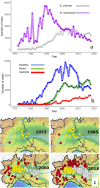Five decades of breeding populations census for 12 species of colonial waterbirds in northwestern Italy
- PMID: 37100803
- PMCID: PMC10133313
- DOI: 10.1038/s41597-023-02072-8
Five decades of breeding populations census for 12 species of colonial waterbirds in northwestern Italy
Abstract
Colonial waterbirds, a major biodiversity element occurring in the core of ultra-anthropized Europe, are ideal indicators of the wellness of inland wetlands. Nonetheless, there is a critical knowledge gap in their trend and population status. We present an uninterrupted 47 years-long dataset of the breeding populations of 12 species of colonial waterbirds (Ardeidae, Phalacrocoracidae, Plataleidae, Threskiornitidae) throughout a 58,000 km2 agricultural region in the higher Po basin (NW Italy). A trained team of collaborators censused with standardized field techniques the number of nests of each species at 419 colonies in the 1972-2018 period, summing up a total of 236,316 records. Data cleaning and standardization were performed for each census year, ensuring robust and consistent data. This dataset is among the largest ever collected for a guild of European vertebrates. It has already been used to describe the factors influencing population trends, and still offers opportunities to explore a wide range of key ecological processes such as biological invasions, global change consequences and biodiversity impact of agricultural practices.
© 2023. The Author(s).
Conflict of interest statement
The authors declare no competing interests.
Figures





References
-
- Cody, M. L. & Smallwood, J. A. Long-term Studies Of Vertebrate Communities (Academic Press, 1996).
-
- Müller F., Baessler, C., Schubert, H. & Klotz, S. (Eds). Long-Term Ecological Research Between Theory And Application (Springer Nature, 2014).
-
- Botsford, L. W., White, J. W. & Hastings A. Population Dynamics For Conservation (Oxford University Press, 2019).
-
- Fasola, M. et al. Changes in rice cultivation affect population trends of herons and egrets in Italy. Glob. Ecol. Conserv. 36, 10.1016/j.gecco.2022.e02135 (2022).
-
- European Environment Agency. Status and trends of bird populations: datasets from Article 12, Birds Directive 2009/147/EC reporting. https://www.eea.europa.eu/data-and-maps/data/article-12-database-birds-d... (2021).
Publication types
MeSH terms
LinkOut - more resources
Full Text Sources
Miscellaneous

